Captivated by charming coastal towns and a picture-postcard setting on a road trip to Nova Scotia’s south shore
One of three Maritime Provinces in eastern Canada, Nova Scotia is a vast peninsula on its western flank with islands to the east. Its most famous and rugged coasts rise out of the Atlantic with a raw, powerful and sometimes wistful beauty. The dramatic Bay of Fundy is known for its massive tide swings, while the famed Cabot Trail on the province’s largest island, Cape Breton, winds past stunning windswept cliffs.
In contrast to those better-known areas, the coastline on Nova Scotia’s south shore is an endless ripple of rocky peninsulas and narrow waterways. Several of the well-protected coves are home to quaint villages that are bright, colorful and utterly picturesque. As my husband, Mark, and I towed our 36-foot fifth-wheel trailer into the province, we debated which coast to head toward. In the end, the charm of those historic seaside settlements on the south shore lured us there first.
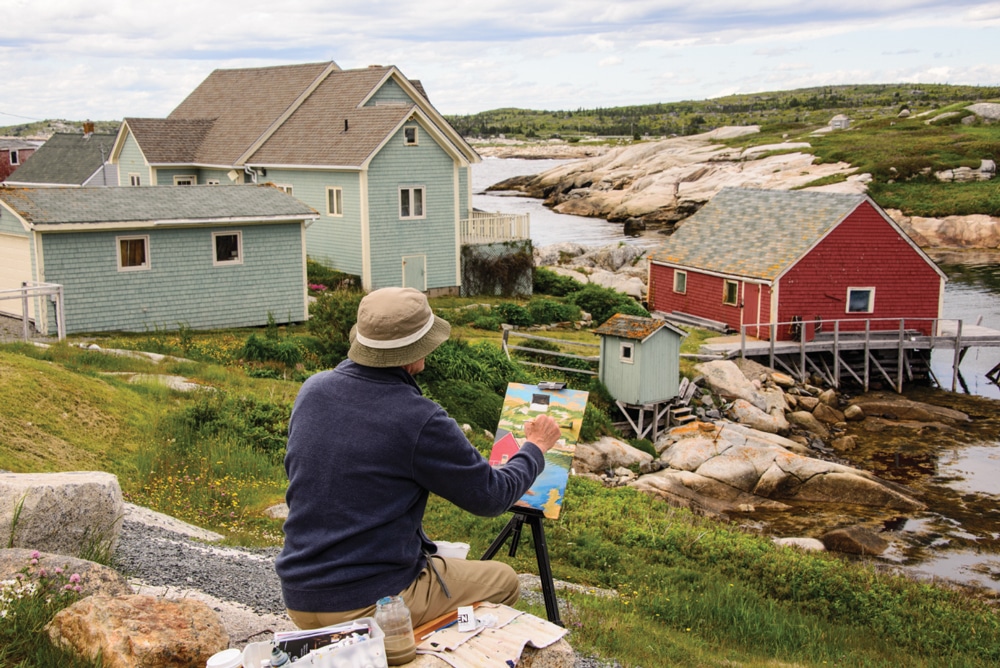
The colorful homes surrounding Peggy’s Cove come to life on an artist’s canvas. Set on picturesque St. Margarets Bay, the village is a popular spot for artists and photographers.
Peggy’s Cove
Our first stop was Peggy’s Cove, a classic fishing village that is picture-postcard perfect. It is a tiny hamlet of just a few simple, pastel-colored homes that are perched on grassy hillsides around a very small harbor. Ever since the area was settled in the late 1700s, the villagers have made their living by harvesting the bounty of the sea. A few lobster boats were tied up at the dock, and their bright blue, yellow and red reflections undulated lazily in the silky water.
As we walked down the narrow lane that meanders alongside the harbor, we passed a lobster boat that had been pulled up on the shore and watched two men busily painting it a vivid red. A lemon-yellow building across the street that housed a coffee shop was practically the only commercial establishment in the village. Traditional wooden lobster pots with rounded tops were stacked up on the small pier, while an abandoned rowboat with peeling paint and rotting wood quietly disintegrated nearby, its days on the water long over.
On a hillside above the town, an artist was seated on a granite boulder painting the tranquil scene, his paintbrush slowly bringing the harbor to life, as a small crowd watched from behind him. Although this is a working fishing community, it is also a popular tourist destination, and the handful of villagers going about their daily lives are vastly outnumbered by camera-wielding tourists. In a distant parking lot, rows of luxury tour buses disgorged hundreds of visitors every hour into this town of 640 residents.
Peggy’s Cove is most famous for its graceful lighthouse, and we wandered away from the harbor out onto the wide, flat granite boulders where it stood facing the open ocean. Three windows decorated its front, like a row of buttons.
Suddenly, the plaintive tones of a bagpipe filled the air, and we saw a man in a kilt near the lighthouse with a donation box at his feet playing his heart out. The mournful song of the bagpipe was beautiful and haunting, evoking the danger of this craggy shore, the fragility of boats at sea, and the thin ray of hope and guidance that a flash of light gives sailors in the dark of night.
Later in the day, as the sun began to fall in the sky, we witnessed one of the most dramatic sunsets we have ever seen. Huge dark storm clouds gathered and turned black above us, while the sun began to slip out of sight below the horizon. It then burst into a brilliant yellow fireball, casting a golden glow between the clouds and sea. All the tourists that had been scrambling around on the rocks stopped to stare, in awe of this magical sunset.
As joyful and glorious as that moment was, a far different and heartbreakingly tragic moment is memorialized forever on another outcropping of waterfront boulders just a few miles away. There, a stark group of engraved granite slabs tells the somber story of the crash of Swissair Flight 111 into the cold Atlantic, killing more than 200 people on board back in 1998. A thick blanket of wet fog covered the shore, as we walked among the stones and pieced together our hazy memories of that news story from long ago, and realized how deeply it affected the people of this distant shore.
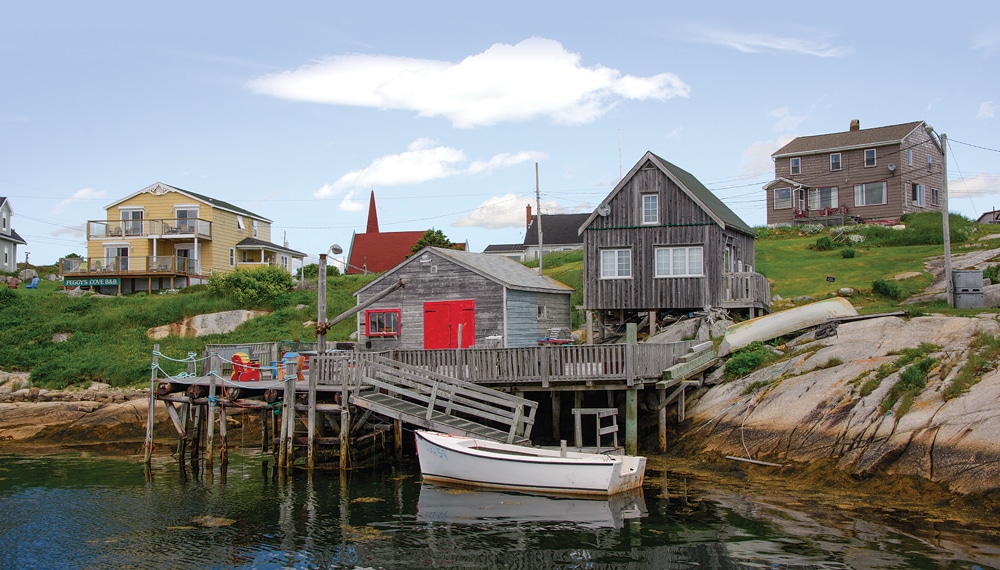
Peggy’s Cove offers a glimpse of a bygone era when fishermen harvested the bounty of the sea.
Lunenburg
Peggy’s Cove had given us a glimpse of life in an isolated cove on Nova Scotia’s south coast, but we found the nearby town of Lunenburg was abuzz with activity. The fishing shacks, shipyard and boathouses along this sizable harbor were all painted bright red, and a wide variety of sailboats and fishing vessels bobbed at anchor in the harbor. Many of the sailboats were antique wooden schooners and ketches from an earlier time. On the town streets, the clip-clop of hooves grew loud, as a horse-and-buggy tour of the town’s historic architecture approached us.
The region was settled primarily by the Scottish (Nova Scotia means “New Scotland” in Latin) and the French, and these two heritages are evident throughout the province. Some towns lean more toward their Scottish roots, and others celebrate deeper French roots. Lunenburg, now a UNESCO World Heritage Site, is unique because its history includes German and Swiss immigrants.
Until the mid-1700s, most Nova Scotia settlements were French, but the British wanted to solidify their presence, so they recruited German and Swiss Protestants, who they hoped would be sympathetic to the British crown, by offering them free land around Lunenburg. The European farmers seized upon this opportunity, and the town was named after the British king of that era who had once been the duke of Braunschweig-Lüneburg.
By the 1860s, the town had a thriving economy based on farming, fishing and trade with the Caribbean islands of the West Indies. Wealthy merchants built elegant homes on the hillside that rises above the harbor. The vibrant and colorful architecture is what gives Lunenburg its immense charm, and we were told that the best view of the town is from the golf course on the far side of the harbor.
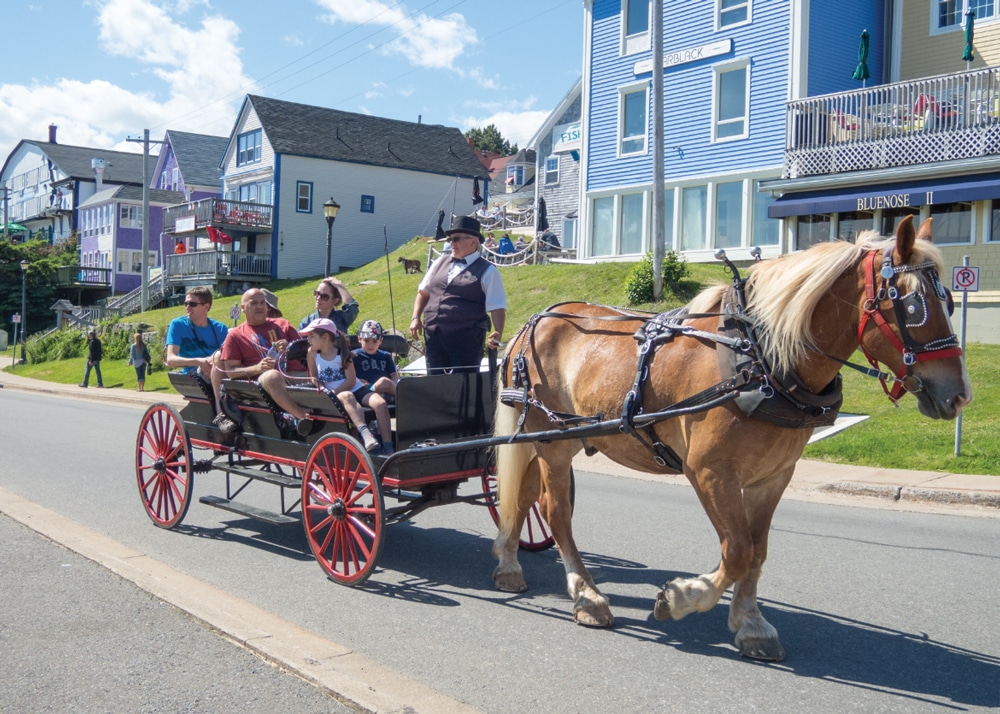
In Lunenburg, tourists see the sights in a horse-drawn wagon.
As we walked along the water’s edge to the other side of the harbor, we passed an imposing piece of concrete with broken edges and discovered it was a piece of the
Berlin Wall. The Kinley family, who has owned the local Lunenburg Industrial Foundry since the mid-1800s, also owned a Volkswagen franchise that was the first importer of the Beetle in Nova Scotia in the 1970s. On a business trip to Germany, CEO J. James Kinley saw the Berlin Wall as he crossed into Soviet-occupied East Berlin through the Friedrichstrasse border crossing (aka Checkpoint Charlie). When the wall fell some years later, he was eager to acquire a piece of it and display it as a symbol of freedom and democracy.
The view of Lunenburg from across the harbor is truly spectacular and well worth the short walk. But perhaps the best view of the town is seen from the water. When we returned to the pier, a group of tourists was boarding a beautiful antique 48-foot wooden ketch, the Eastern Star, for a day sail around the harbor. Blowing a loud blast on a conch shell, the captain took his position behind the old wooden-handled helm and steered the boat between the anchored sailboats. With its sails flying high, the yacht cruised past the shoreline several times, creating a magical illusion of 19th-century Lunenburg juxtaposed onto 21st-century life.
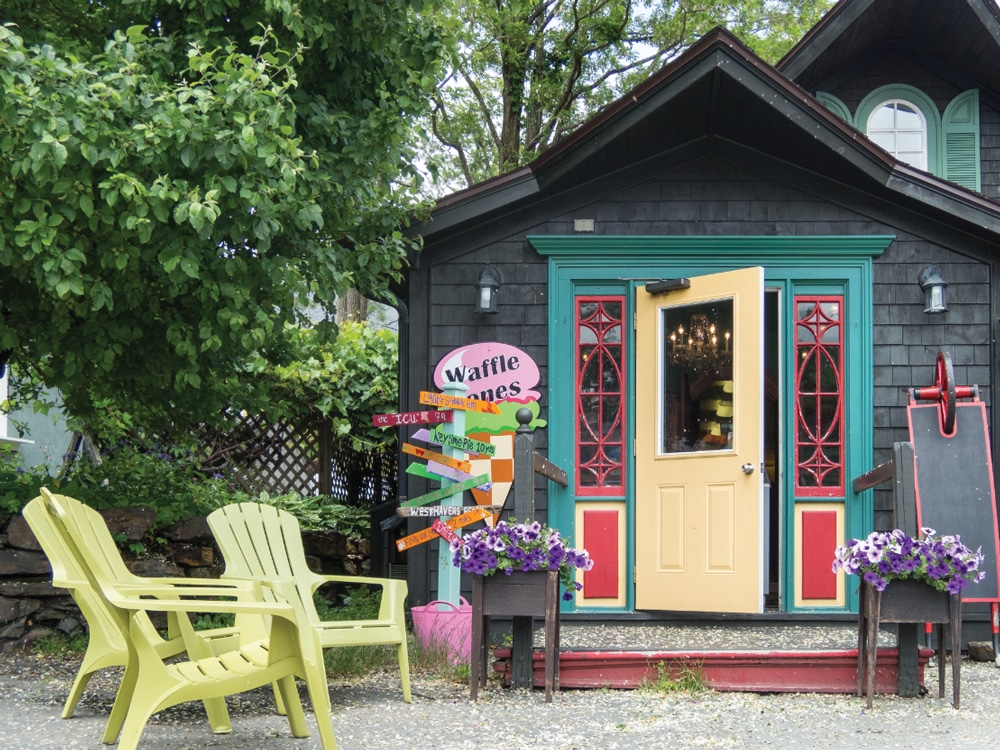
Cute eateries and boutiques give Mahone Bay a special charm.
Mahone Bay, Blue Rocks and the LaHave ferry
The shoreline roads are more than worthy of a leisurely drive in the tow vehicle, and we enjoyed an excursion to the town of Mahone Bay and the settlement at Blue Rocks. Mahone Bay overlooks a harbor, and a quiet morning stroll took us past a handful of boutique shops. The curves of the shoreline were decorated with an ornate yellow church and some stately homes. There are several eateries, and we got a kick out of the Tea Brewery, a store devoted to all things tea. Coming from the intense coffee culture in America, this was a delightful switch that reminded us of Canada’s strong British ties.
Further out on a craggy peninsula, in the community of Blue Rocks, we found a few scattered houses and lobster shacks spread out around a rocky cove and pebble beach. Lobstermen plied their trade on small boats in the tiny bay, and a smattering of modest homes were tucked into the craggy shore. The piercing cries of seagulls punctuated the air, and the seaweed on the rocks swished back and forth with the swell.
Another way to get out on the water in this part of Nova Scotia is to take a ferry. South of Lunenburg, a lovely coastal road runs right along the shoreline of the LaHave River, a tidal waterway. At the mouth of the river, where it opens up to the ocean, the LaHave ferry zips back and forth between the two shores all day long. Tickets are first-come, first-served, and you simply drive up to the dock, wait for the ferry to land, drive aboard and enjoy a five- to 10-minute ride to the other side. The cost is just a few dollars.
We got a kick out of seeing a small Class C motorhome being ferried across the bay. Small trailers are OK on the ferry and narrow coastal roads. Larger trailers and fifth-wheels would be difficult to navigate through the tight turns and busy town streets.
These images of Nova Scotia’s south shore will remain forever in our memories. It’s not a short jaunt for most visitors to reach this remote corner of the continent, but it is well worth the towing miles to take your RV there and settle in for a while.
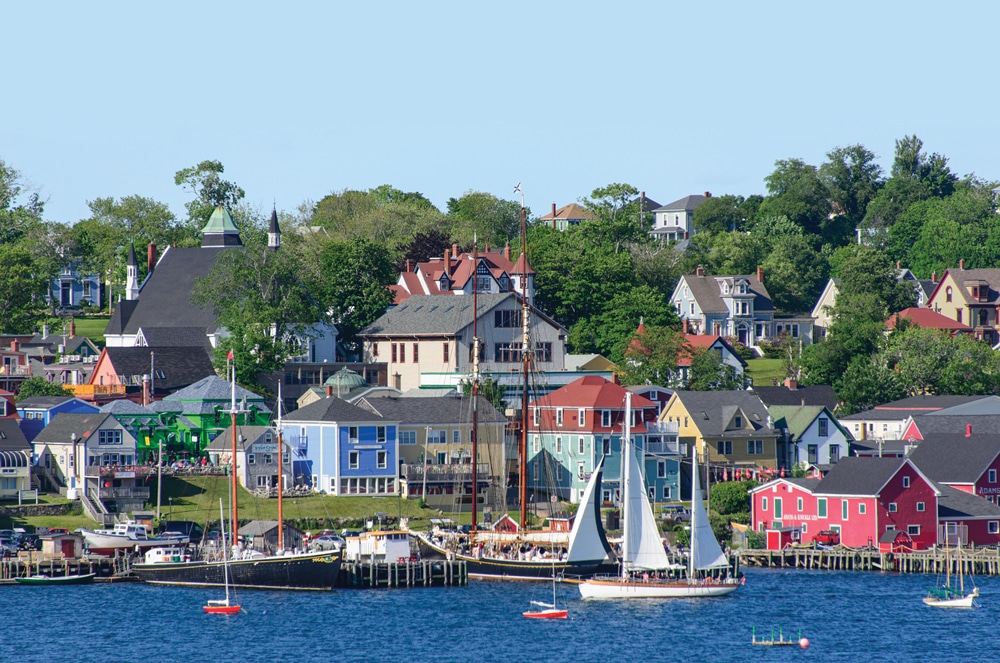
Classic schooners and ketches fill the harbor at Lunenburg, settled in the mid-1700s.
Canadian Customs
Documentation
Americans may stay in Canada for up to six months without a visa. A passport or passport card is required to re-enter the United States.
Metric System
Canada uses the metric system, so temperatures are in Celsius, distances are in kilometers, and volume is in liters.
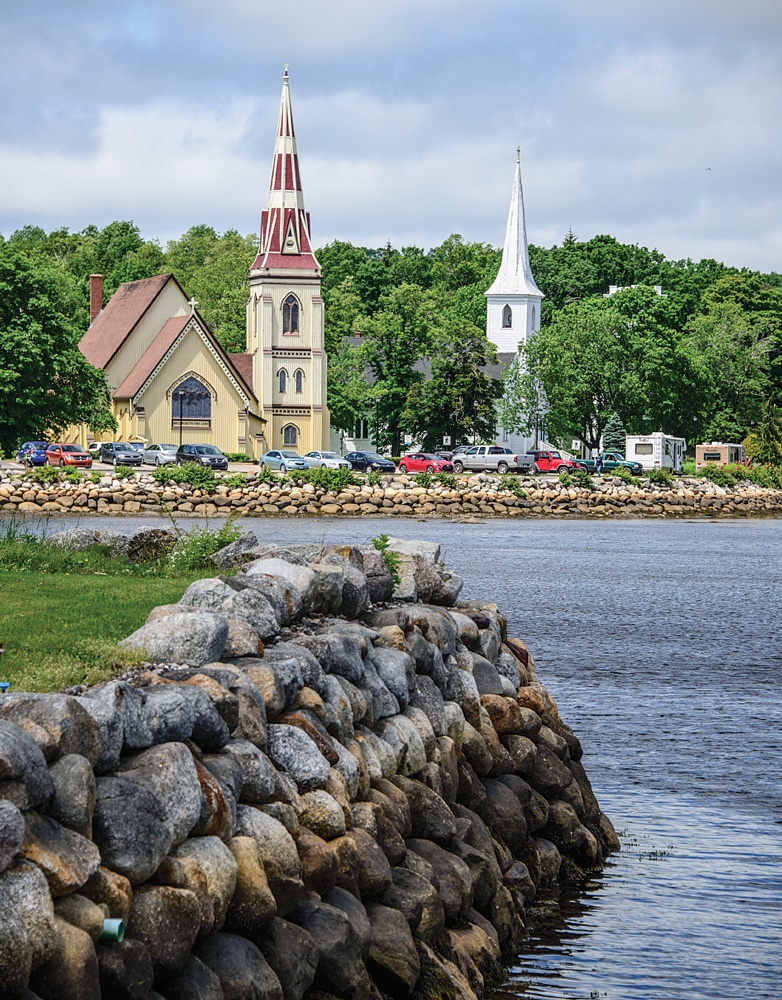
Completed in 1887, the elegant St. James church makes a striking image on the shores of Mahone Bay in the harbor town named for the waterway.
Time Zone
Nova Scotia and New Brunswick are in the Atlantic Time Zone, one hour earlier than Eastern Standard Time.
Expenses
We typically paid about 20 percent more for diesel fuel in Canada. Groceries ran about 5 to 10 percent higher for identical items in Nova Scotia than in New England. Beer and cigarettes are heavily taxed. Nova Scotia imposes a 15 percent sales tax, so before snapping up a deal, remember that it will cost that much more than the sticker price.
Bank Fees
U.S. banks generally impose a 3 percent fee for credit-card and debit-card transactions in Canada; some credit cards waive the currency-exchange fee. Notify your financial institutions ahead of time that you will be making purchases in Canada.
Cellular Service
If you have a U.S. cellular plan, you will likely pay a higher rate for voice and data service in Canada. Check with your provider about Canadian roaming options before crossing the border. Free open-access (no password) Wi-Fi is readily available in Nova Scotia, from town halls to visitor centers, RV parks and coffee shops.
Weather
Summer temperatures can be in the 80s Fahrenheit, but during our visit, we had a lot of rainy days in the 60s. Be prepared for a little bit of everything on the coast.
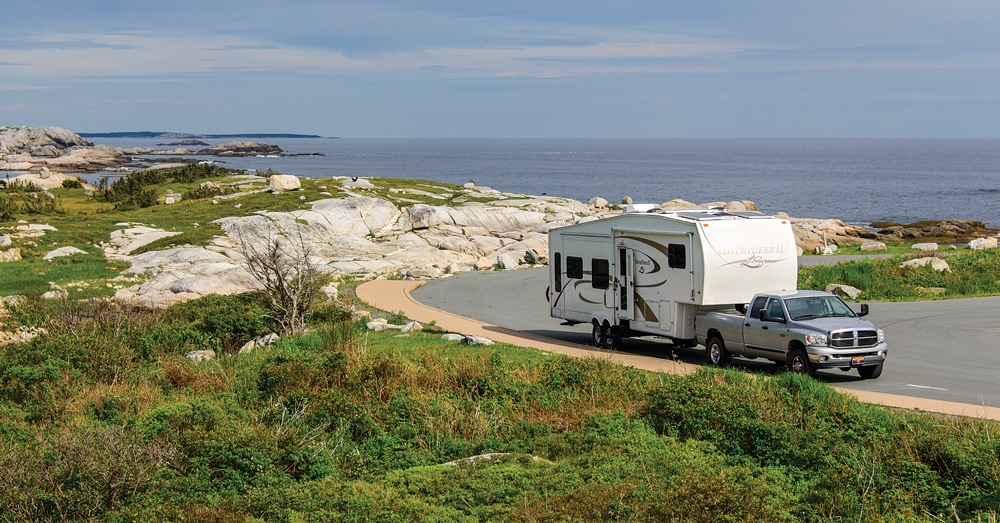
A trip to Nova Scotia is well worth the miles to get there. Some coastal routes are suitable for large RVs, but it’s best to unhitch and take the tow vehicle on all but the main roads.
RV Camping
BRIDGEWATER
Oakhill Pines Campground | www.oakhillpines.com
HAMMONDS PLAINS
Woodhaven RV Park of Halifax | www.woodhavenrvpark.com
HUBBARDS
Hubbard’s Beach Campground | www.hubbardsbeach.com
INDIAN HARBOUR
King Neptune Campground | www.kingneptunecampground.ca
MARTIN’S RIVER
RayPort Campground | www.rayport.ca
For More Information
Tourism Nova Scotia | www.novascotia.com
Trailer Life columnist and frequent contributor Emily Fagan has traveled full time by RV and sailboat with her husband, Mark, since 2007. The couple’s photos have appeared on more than 25 magazine covers and wall calendars, and Emily’s lifestyle, travel and how-to articles have been featured in more than a dozen RV and sailing publications. Follow their adventures on their blog, Roads Less Traveled.

